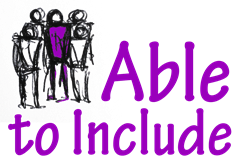ABLE-TO-INCLUDE aims to improve the quality of life of people with Intellectual or Developmental Disabilities (IDD) by creating a new open User Centred Accessibilty Layer that will empower our target group to use internet and social media applications on their phone, tablets and personal computers. This will be done by providing text simplification, pictograph conversions and text-to-speech services that will make the applications extremely easy to use.
The system will be tested in three pilot studies involving real life situations, implemented in Spain, Belgium and the UK, in close collaboration with several associations for intellectually disabled individuals. These trials will validate the effectiveness of the new system in several scenarios that reflect the most important areas that a person needs to live independently and find fulfillment as an individual: to socialize in the context of the web 2.0, to travel independently and to be able to work.
To produce the Accessibility Layer, the project will involve users with IDD in the design process of the Accessibility Layer itself, by:
1. Making each circumstances of its use as realistic, fun and attractive for the users as possible
2. Assisting the users with people that are familiar to them and their situation
3. If necessary, initially using stand-ins, who are very familiar with the target group of users with intellectual disabilities and the context of use.
While possibly starting with stand-ins (mainly from the relevant project partners) the process will involve an adapted User Centred Design (UCD) approach of iterative operational prototypes to completing the Accessibility Layer functionality and very simple user interface, involving:
1. Many meetings, surveys and interviews on-site with the people and their carers,
2. Observations of users’ of the pilot applications, particularly their motivation to use them – what they do and do not like to do.
ABLE-TO-INCLUDE will contribute to many EU and national policies and standards, and while there is an enormous amount to be learned from the experience and work of previous projects and initiatives, the Accessibility Layer will be developed as a self-sufficient cloud-based operational service with a very simple user interface.
All European citizens should be using Future Internet interactive, multimedia and multi-device services that are fully inclusive and accessible to everyone, everywhere, everytime they wish to use them, and the ABLE-TO_INCLUDE Accessibility Layer will directly contribute to improving such eAccessibility across Europe.
The ABLE-TO-INCLUDE Partners believe that eAccessibility begins with open and transparent communication between providers and users. This information must be delivered in a way that is not only accessible to individuals but also meets their needs – ‘anytime, anyhow, anywhere’. Most people (including those with IDD) are “on-demand” users of multimedia interactive services, and service providers need to accept this and deliver information and web-services in a convenient format. The consortium believes that the ABLE-TO-INCLUDE Accessibility Layer and applications will meet these needs and is an effective pillar on which to build a very strong eAccessibility and eInclusion agenda across Europe.

